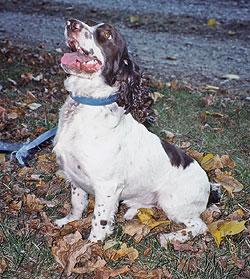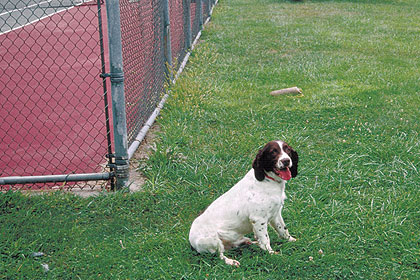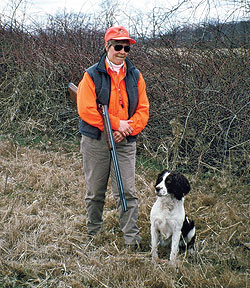But act like a trainer, not a drill sergeant.
By John McGonigle
 Pup sits with lead attached to learn the "hup" command. |
Boot camp transforms even the toughest recruits and molds them into sound, disciplined performers in the field, whatever their endeavor. Yes, there is serious work involved, but that is how it is with most worthwhile endeavors.
Our primary goals for pup's boot camp are that when completed, pup will sit, stay and come on command immediately and reliably.
After boot camp, more commonly called "yard training" for gun dogs, compliance should occur with the first command, and should occur consistently, every time thereafter.
Unlike military boot camp, however, loudness or shouting is unnecessary, even detrimental. Additionally, pup should not be hit, abused, or thrown down at any time.
Repetition and consistency get this chore done, and the effects last longer than loudness or force.
This is a good time to get pup started, whether you are starting a youngster's career or a want to reapply some spit-n-polish to a veteran's performance.
It takes about a year of boot camp for your young pup (not bad for a 10 to 12 year payback) and a month for your veteran. You can do that in just 15 minutes daily over the first six months and 20 to 30 minutes daily for the next six months. Do that and you will likely have the best gun dog in your circle of friends.
Naturally you will do other drills and activities with pup during this time, especially taking him into the fields and woods.
A young pup requires much more time and patience than veterans.
Starting a young pup has the added benefit of re-instilling us with optimism and hope for the future — do not underestimate the benefits of those emotions, especially as we move into our more mature years.
"Hup" (sit) and "come" comprise the verbal commands. One toot on the whistle means "hup" and repetitive toots mean "come."
A fenced yard to restrict pup is a great place for training; a garage or basement will also work. Training alone helps pup concentrate on you and his lessons; it's a good idea for quite some time.
A lot of spaniel and pointing dog folks do not teach pup to heel because they feel it teaches him too much restraint before he develops enough boldness to get out and hunt.
That is your decision, but if nothing else, pup must learn to walk "on lead," or on a leash, before you can accomplish much.
"Hup" is the traditional spaniel command for sit, but use "sit" if it makes you more comfortable. Teaching pup to hup when it suits him is pretty easy; getting him to sit on command is a lot more work but it is critical, as is getting him to remain seated until you release him.
Use a light, six-foot lead and walk him in your contained area. Force him to remain close to you with the lead and say "hup," at the same time pushing his hindquarters to the ground while pulling his head upwards and slightly back.
 Pup sits without restraint in a park (near fence) to learn to deal with distractions while the "hup" command is reinforced. |
Say nothing while holding him in that position for several seconds and resume your walking around as you say "come." Do that five to 10 times and then play with pup. If pup moves towards you, say "no" and quickly put him back in place.
As pup's response improves, increase the length of time you hold him in the hup position.
Give him a quick pat on the head and say "good boy" before releasing him as deserved.
Pup should sit on command after about three weeks, but don't stop there.
We do not use the command "stay" to make pup stay; rather, we just do not give him a release command. When we say "hup" we also mean stay until released with a "come" or "get out" command.
Walk pup around, say hup and raise your hand in the air with your palm facing pup. With his posterior firmly on the ground, step one step away from pup with your hand still up, and repeat "hup" if necessary to let him know that is your expectation.
If pup remains seated wait just five to 10 seconds; step back to him and resume walking, saying "come." If pup moves say "no" and quickly put him back in the hup position, holding him there for ten seconds.
Increase the time you wait, and once he becomes compliant take another two or three steps from pup when he sits. Increase pup's time of compliance and your distance from pup, and then move to one side and then the other when in front of your sitting pup.
Increase pup's "sitting" time to a minute, and keep working until you can walk in a circle around pup while he sits.
Do not holler the command, or ever holler at pup. Do not forget the quick head pat and "good boy" before walking off, but do not overdo the praise — "gushing" tends to wash out what he has just learned.
After getting good compliance from pup, start using the command "hup" when he is several feet away. He should drop like a shot. If he doesn't, step quickly toward him and push his hindquarters to the ground at the spot where he was when you gave the "hup" command.
Again, do not holler; pick him up with each hand holding him by the loose skin at the sides of his neck, below the ears, with his body hanging off the ground. Do not drop or throw pup, but set him firmly on the ground at the spot where he ignored your command while commanding "hup.
 Pup is alert yet controlled while waiting to begin hunting. |
Give pup the "hup" command when he is farther and farther away, lengthening the distance gradually.
After working "hup" for a couple weeks, and after introducing the palm-out hand signal, introduce the whistle signal for pup to sit. Say "hup" and immediately toot your whistle one time. Make sure pup sits immediately. Continue using voice and whistle commands.
Eventually only the whistle will be used in the field.
Being able to make pup sit where and when you want is very important. It can keep pup from running onto a road, running toward people or other dogs or getting into myriad troublesome situations.
Keeping pup seated is also necessary to teach pup to retrieve, and is further needed when you want pup to sit with you to hunt doves or waterfowl.
"Hup" is the basis of all control with pup, and control is the primary factor pup needs throughout his days with you, especially in the field.
Hup pup each time before allowing him to go through a door to go inside or outside. Hup him before he enters or leaves his crate, gets in or out of a vehicle, when you stop walking when he is on lead and before casting him off (releasing him) to train or hunt in the field.
I work pup into "come" without him being aware of it. When he is very young he will not want to get far from you. If he realizes any decent-sized gap has occurred he will run to you immediately; remember, he's just a little guy and not very confident.
When pup is away and you see he is preparing to hightail it back to you, say "come," and guess what? Pup's coming like a freight train. Pet him and tell him good boy, love him up good. A few weeks of that and he'll start coming on command even when he was not already on his way.
Do not command "come" if he is showing great interest in something (he'll ignore you), but only when he is just wandering around.
Now put the lead on and command "hup." Wait a few seconds, then command "come."
He will likely come, but if he does not respond immediately, just pull him in gently by his leash. Hup him again and repeat.
Start with just several repetitions and gradually increase the repetitions. Do not forget the head pat and "good boy" when he complies.
When pup understands the voice command "come," use your whistle by tooting it repetitively right after saying "come." He will quickly recognize repetitive toots as meaning come; use that in the field.
Continue drilling pup, but remember not to do too much at once session. Keep pup happy and take a break if he appears frustrated or bored. A nice romp is a good way to end each session.






